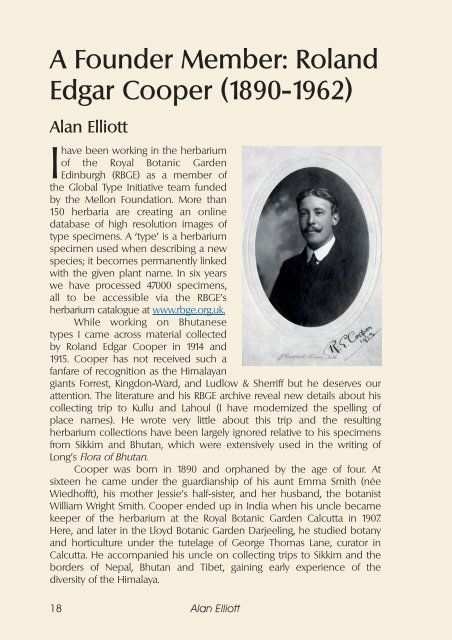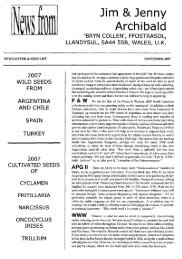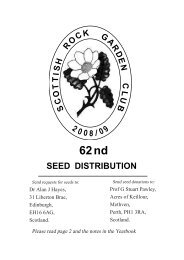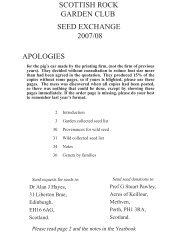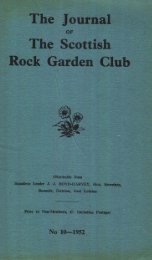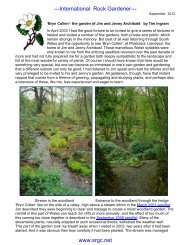A Founder Member: Roland Edgar Cooper (1890-1962)
A Founder Member: Roland Edgar Cooper (1890-1962)
A Founder Member: Roland Edgar Cooper (1890-1962)
You also want an ePaper? Increase the reach of your titles
YUMPU automatically turns print PDFs into web optimized ePapers that Google loves.
A <strong>Founder</strong> <strong>Member</strong>: <strong>Roland</strong><br />
<strong>Edgar</strong> <strong>Cooper</strong> (<strong>1890</strong>-<strong>1962</strong>)<br />
Alan Elliott<br />
Ihave been working in the herbarium<br />
of the Royal Botanic Garden<br />
Edinburgh (RBGE) as a member of<br />
the Global Type Initiative team funded<br />
by the Mellon Foundation. More than<br />
150 herbaria are creating an online<br />
database of high resolution images of<br />
type specimens. A ‘type’ is a herbarium<br />
specimen used when describing a new<br />
species; it becomes permanently linked<br />
with the given plant name. In six years<br />
we have processed 47000 specimens,<br />
all to be accessible via the RBGE’s<br />
herbarium catalogue at www.rbge.org.uk.<br />
While working on Bhutanese<br />
types I came across material collected<br />
by <strong>Roland</strong> <strong>Edgar</strong> <strong>Cooper</strong> in 1914 and<br />
1915. <strong>Cooper</strong> has not received such a<br />
fanfare of recognition as the Himalayan<br />
giants Forrest, Kingdon-Ward, and Ludlow & Sherriff but he deserves our<br />
attention. The literature and his RBGE archive reveal new details about his<br />
collecting trip to Kullu and Lahoul (I have modernized the spelling of<br />
place names). He wrote very little about this trip and the resulting<br />
herbarium collections have been largely ignored relative to his specimens<br />
from Sikkim and Bhutan, which were extensively used in the writing of<br />
Long’s Flora of Bhutan.<br />
<strong>Cooper</strong> was born in <strong>1890</strong> and orphaned by the age of four. At<br />
sixteen he came under the guardianship of his aunt Emma Smith (née<br />
Wiedhofft), his mother Jessie’s half-sister, and her husband, the botanist<br />
William Wright Smith. <strong>Cooper</strong> ended up in India when his uncle became<br />
keeper of the herbarium at the Royal Botanic Garden Calcutta in 1907.<br />
Here, and later in the Lloyd Botanic Garden Darjeeling, he studied botany<br />
and horticulture under the tutelage of George Thomas Lane, curator in<br />
Calcutta. He accompanied his uncle on collecting trips to Sikkim and the<br />
borders of Nepal, Bhutan and Tibet, gaining early experience of the<br />
diversity of the Himalaya.<br />
18 Alan Elliott
<strong>Cooper</strong> returned to Scotland in 1910, when Wright Smith took up a<br />
post at RBGE to describe George Forrest’s collections then being received<br />
from Yunnan. Intending to become a fruit farmer in British Columbia, he<br />
was tutored by Professor Isaac Bayley Balfour. However, before finishing his<br />
studies, and with the encouragement of Wright Smith and Balfour, he<br />
agreed to lead a collecting expedition to Sikkim, sponsored by A K Bulley<br />
of Ness Gardens.<br />
Sikkim (1913)<br />
The main purpose of <strong>Cooper</strong>’s trips was to introduce horticultural<br />
novelties into cultivation, with botanical collecting only a secondary<br />
concern. He started at Kurseong, headed north to Darjeeling, then west to<br />
Pallut on the border of Nepal, before returning to Darjeeling. He went<br />
northeast to Gangtok and explored valleys and passes around the<br />
Chumbi Valley. He also explored the Lachen and Yamgtang valleys,<br />
respectively northwest and northeast of Chungthang, visiting ground<br />
Table 1: New taxa collected by <strong>Cooper</strong> in Sikkim<br />
Number Type collection Currently accepted name<br />
20 Primula calderiana Balf.f. & R.E.<strong>Cooper</strong> Primula calderiana Balf.f. & R.E.<strong>Cooper</strong><br />
118 Poa cooperi Noltie Poa cooperi Noltie<br />
160 Euphorbia luteoviridis D.G.Long Euphorbia luteoviridis D.G.Long<br />
166 Sedum bhutanicum Praeger:<br />
Rhodiola bupleuroides (Wall. ex Hook.f.<br />
Sedum cooperi Praeger<br />
& Thomson) S.H.Fu<br />
299 Physospermopsis bhutanensis Farille & Physospermopsis kingdon-wardii<br />
Malla<br />
(H.Wolff) C.Norman<br />
349 Primula cooperi Balf.f. Primula cooperi Balf.f.<br />
438 Primula lacteocapitata Balf.f. & W.W.Sm. Primula capitata Hook.f. ssp.<br />
lacteocapitata (Balf.f. & W.W.Sm.)<br />
W.W.Sm. & Forrest<br />
440 Sedum pseudostapfii Praeger: Sedum filipes Hemsl.<br />
508 Salvia campanulata Wall. ex Benth. var. Salvia campanulata Wall. ex Benth. var.<br />
hirtella E.Peter<br />
hirtella E.Peter<br />
593 Potentilla tapetodes Soják var. decidua Potentilla microphylla D.Don var.<br />
Soják<br />
microphylla<br />
605 Delphinium aureopilosum Chowdhury ex<br />
Mukerjee<br />
Delphinium viscosum Hook.f. & Thomson<br />
714 Salvia sikkimensis E.Peter var.<br />
Salvia campanulata Wall. ex Benth. var.<br />
chaenocalyx E.Peter<br />
fissa E.Peter<br />
725 Euphrasia chumbica R.R.Mill Euphrasia chumbica R.R.Mill<br />
772 Lalldhwojia cooperi Farille Lalldhwojia staintonii Farille<br />
793 Lactuca cooperi Anth. Youngia depressa (Hook.f. & Thomson)<br />
Babc. & Stebbins<br />
845 Corydalis changuensis D.G.Long Corydalis changuensis D.G.Long<br />
884 Pedicularis cooperi P.C.Tsoong Pedicularis cooperi P.C.Tsoong<br />
893 Primula cooperi Balf.f. Primula cooperi Balf.f.<br />
907A Parnassia cooperi W.E. Evans Parnassia cooperi W.E. Evans<br />
923 Sedum crassipes Hook. f. & Thomson<br />
var. cholaense Praeger:<br />
Rhodiola wallichiana (Hook.) S.H.Fu<br />
951 Primula crispata Balf.f. & W.W.Sm. Primula capitata Hook.f. ssp. crispata<br />
(Balf.f. & W.W.Sm.) W.W.Sm. & Forrest<br />
A <strong>Founder</strong> <strong>Member</strong>: <strong>Roland</strong> <strong>Edgar</strong> <strong>Cooper</strong><br />
19
previously covered by Joseph<br />
Hooker. A list of new species and<br />
varieties from these Sikkim<br />
collections includes almost two<br />
dozen species, although some are<br />
no longer considered to be distinct<br />
from earlier taxa.<br />
Through Bulley, RBGE received<br />
over 500 seed collections from this<br />
trip, many of which neither<br />
germinated nor persisted in<br />
cultivation at Edinburgh. However,<br />
two forms of Meconopsis<br />
simplicifolia (D.Don) Walp. grew<br />
there for some years; <strong>Cooper</strong><br />
attributed its eventual decline to a<br />
lack of moisture in Edinburgh<br />
relative to that of its home. Despite<br />
the number of collections, this trip<br />
was deemed a failure, yielding few<br />
‘novelties’. Horticulturally, his best<br />
known discovery from Sikkim is<br />
Primula calderiana, described by<br />
him and his mentor Bayley Balfour.<br />
Copper later paid tribute to an<br />
important member of his company,<br />
Rohmoo Lepcha. Lepchas are<br />
indigenous to Sikkim, renowned for<br />
their knowledge of and respect for<br />
nature; several were employed as<br />
collectors by the Calcutta Botanic<br />
Garden. Rohmoo worked for William<br />
Wright Smith and George H Cave<br />
during their 1909–1910 collecting<br />
trips in Sikkim. <strong>Cooper</strong> first met<br />
Rohmoo during the preparations for<br />
his 1913 trip to Sikkim and employed<br />
him as his chief collector on his four<br />
trips in Sikkim, Bhutan and<br />
northwest India.<br />
The literature surrounding<br />
<strong>Cooper</strong> refers to his visits to the<br />
Tibetan border while accompanying<br />
20 Alan Elliott<br />
Primula calderiana<br />
(Photo: R E <strong>Cooper</strong>)<br />
Rohmoo with Meconopsis wallichii
Wright Smith. His own pass did not allow him into the Chumbi Valley but<br />
Rohmoo was able to enter and collected what later became Primula<br />
chumbiensis W. W. Sm. - probably from the same spot that he had<br />
collected it in 1912 - and which forms part of the Edinburgh type<br />
collection.<br />
Bhutan (1914–15)<br />
After William Griffith in 1837, <strong>Cooper</strong> was the second major plant<br />
collector to enter Bhutan. He covered much of the same ground but<br />
explored more of the country than had Griffith. In 1914 his itinerary took<br />
him to the centre and western regions. The 1915 excursion repeated some<br />
of this before heading northeast. He much later (1929 to 1955) published a<br />
Table 2: New taxa collected by <strong>Cooper</strong> in Bhutan<br />
Number Currently Accepted Name Number Currently Accepted Name<br />
1454,1545, Rhododendron maddenii Hook.f. ssp. 3816 Rhododendron papillatum Balf.f. &<br />
3936 maddenii<br />
3885 <strong>Cooper</strong><br />
1601,1771,<br />
3470,4056<br />
Primula bellidifolia King 3837 Primula atrodentata W.W.Sm.<br />
1670 Physospermopsis kingdon-wardii 3903 Rhododendron anthopogon D.Don ssp.<br />
(H.Wolff) C.Norman<br />
anthopogon<br />
1695 Potentilla spodiochlora Soják 3937 Rhododendron dalhousieae Hook.f. var.<br />
rhabdotum (Balf.f. & R.E.<strong>Cooper</strong>)<br />
Cullen<br />
1878,2952 Silene indica Roxb. var. bhutanica 3943 Leucophysalis yunnanense (Kuang &<br />
(W.W.Sm.) Bocquet<br />
Lu) Averett ssp. bhutanica Grierson &<br />
Long<br />
1994,2990 Swertia staintonii Harry Sm. 3959<br />
4083<br />
Rhododendron camelliiflorum Hook.f.<br />
1996 Saxifraga tsangchanensis Franch. 3981 Primula bracteosa Craib<br />
2134,4042 Primula umbratilis Balf.f. &<br />
R.E.<strong>Cooper</strong><br />
4000 Primula calderiana Balf.f. & R.E.<strong>Cooper</strong><br />
2148,3990 Rhododendron flinckii Davidian 4072 Primula calderiana Balf.f. & R.E.<strong>Cooper</strong><br />
ssp. strumosa (Balf.f. & R.E.<strong>Cooper</strong>)<br />
A.J.Richards<br />
2224,4009,<br />
4285<br />
Rhododendron baileyi Balf.f. 4099 Lobelia nubigena J.Anthony<br />
2294 Delphinium cooperi Munz 4115 Rhododendron argipeplum Balf.f. &<br />
R.E.<strong>Cooper</strong><br />
2367 Primula denticulata Sm. 4154 Buddleja forrestii Diels<br />
2508 Corallodiscus bhutanicus (Craib) 4173,4273 Primula dickieana Watt var.<br />
B.L.Burtt<br />
aureostellata (Balf.f.& <strong>Cooper</strong>) Fletcher<br />
2508A Corallodiscus cooperi (Craib)<br />
B.L.Burtt<br />
4236,4975 Primula eburnea Balf.f. & R.E.<strong>Cooper</strong><br />
2524 Berberis praecipua C.K.Schneid. 4247 Primula dryadifolia Franch. Ssp.<br />
jonardunii (W.W.Sm.) Chen & Hu<br />
2744 Pedicularis microloba R.R.Mill 4268 Cortiella hookeri (C.B.Clarke)<br />
C.Norman<br />
3227 Silene purii Bocquet & Saxena 4304 Pedicularis sanguilimbata R.R.Mill<br />
3240 Kedarnatha oreomyrrhiformis (Farille<br />
& S.B.Malla) Pimenov & Kljukov<br />
4344 Rubus cooperi D.G.Long<br />
3301 Indigofera pseudoreticulata Grierson<br />
& Long<br />
4393,4977 Primula xanthopa Balf.f. & R.E.<strong>Cooper</strong><br />
3311<br />
3315<br />
Cotoneaster bacillaris Wall. ex Lindl. 4533 Keraymonia pinnatifolia M.F.Watson<br />
3449 Erysimum afghanicum Kitam. 4806 Gentiana lacerulata Harry Sm.<br />
3499 Gentiana prolata Balf.f. 4807 Primula sikkimensis Hook.f. var.<br />
hopeana (Balf.f. & R.E.<strong>Cooper</strong>)<br />
W.W.Sm. & H.R.Fletcher<br />
3517 Rhodiola bupleuroides (Wall. ex<br />
Hook.f. & Thomson) S.H.Fu<br />
A <strong>Founder</strong> <strong>Member</strong>: <strong>Roland</strong> <strong>Edgar</strong> <strong>Cooper</strong><br />
21
series of accounts of these<br />
expeditions.<br />
<strong>Cooper</strong>’s main objective in<br />
Bhutan was again to collect<br />
horticultural novelties, focusing on<br />
Rhododendron and Primula.<br />
However, as Bhutan was almost<br />
completely unknown, his collection<br />
of 3958 numbers was both significant<br />
and substantial. Letters from Balfour<br />
to <strong>Cooper</strong> in the RBGE archive<br />
convey the excitement of his being<br />
allowed access to Bhutan, and<br />
McLean recounted Bulley’s near<br />
euphoria at securing permission for<br />
<strong>Cooper</strong> to enter the reclusive<br />
kingdom. Once there, he collected<br />
an astonishing 42 species of<br />
Rhododendron - eight of them new<br />
to science, and 51 species of Primula<br />
- 19 new to science. Subsequent<br />
taxonomic research has found most<br />
of these not to be distinct and they<br />
have sunk into synonymy. In total, 63<br />
of his Bhutanese collections helped<br />
describe new species or varieties,<br />
with 32 still recognised as distinct.<br />
<strong>Cooper</strong>’s most important<br />
horticultural introduction from<br />
Bhutan was that of Viburnum<br />
grandiflorum Wall. ex DC. This was<br />
used as one of the parents for the<br />
cross that created V. x bodnantense<br />
Aberc. ex Stearn. The original cross of<br />
Viburnum farreri Stearn (syn. V.<br />
fragrans Bunge) and V. grandiflorum<br />
was made in 1933 at RBGE by the<br />
then assistant curator Charles Lamont,<br />
and again in 1934/35 at Bodnant<br />
Garden in North Wales, from which<br />
the cross derives its name.<br />
<strong>Cooper</strong> attributed some of his<br />
most famous collections to what he<br />
called ‘Plant Hunter’s Luck’, when<br />
22 Alan Elliott<br />
Lobelia nubigena type locality<br />
(Photo R E <strong>Cooper</strong>)
‘Baleful influences masked as livid beasts &<br />
ogres who are vanquished by the good in<br />
the dance’. Words and photo (R E <strong>Cooper</strong>)<br />
unique plants could literally<br />
be ‘fallen upon ’. In 1942 such<br />
an accident resulted in a new<br />
find. While crossing steep<br />
scree the ground gave way,<br />
he was thrown to his back<br />
and began to slide, grabbing<br />
vegetation to stop his fall.<br />
Once retrieved by his men,<br />
part of a branch was pulled<br />
off a shrub to help him along.<br />
The branch had flowers and<br />
appeared to be something<br />
new – it was pressed and subsequently described by Wright Smith as<br />
Buddleja cooperi. <strong>Cooper</strong> commented that his ‘party were so happy-golucky<br />
and casually careless resulting in frequent acts of dare-devilry which<br />
might easily have meant mutilation or worse ’!<br />
One of <strong>Cooper</strong>’s most interesting discoveries was a large member of<br />
the family Campanulaceae on the Black Mountain, subsequently<br />
described by John Anthony as Lobelia nubigena. This has a ‘pachycaul’<br />
(thick-stemmed) growth habit and was then thought to be related to the<br />
tree lobelias of the mountains of equatorial Africa. <strong>Cooper</strong> described this<br />
plant’s occurrence in Bhutan as ‘a problem yet to be resolved ’. On the<br />
southern mountain ranges of Bhutan he found Rhododendron<br />
rhabdotum Balf.f. & R.E.<strong>Cooper</strong>, now treated as a variety of R. dalhousieae<br />
Hook.f. He described this as ‘a marvel with large red stripes down the 4<br />
inch white corolla ’.<br />
<strong>Cooper</strong> published how Primula eburnea Balf.f. & R.E.<strong>Cooper</strong> was<br />
discovered and introduced into cultivation and he paid tribute to another<br />
member of his party, a Lepcha called Paulo. Paolo was stranded on the<br />
wrong side of a river after a bridge was washed away; he then walked for<br />
a month, the long way round, to bring <strong>Cooper</strong> the seed. During the trek<br />
Paulo fell ill with a fever and spent eight days in delirium; ignoring advice<br />
to rest from the monks who were caring for him, he returned to re-join<br />
<strong>Cooper</strong>’s party. It is testament to <strong>Cooper</strong>’s good relations with his<br />
collectors that Paulo volunteered for the 1916 trip, despite his still being ill.<br />
<strong>Cooper</strong> also was fascinated by Bhutanese people. In 1933, well after<br />
the event, he wrote about the ‘Daktas ’, people living in the east of Bhutan<br />
who had been described to him as ‘tailed men ’. Initial excitement at<br />
possibly discovering the ‘missing evolutionary link ’ was short lived. The tail<br />
‘consisted of a flat, round pad nine inches in diameter, made of either yak<br />
or goat hair. The wearers said that the pad was put on in their youth and<br />
was never removed. It was said to be used as a resting pad when loads<br />
were carried.’<br />
A <strong>Founder</strong> <strong>Member</strong>: <strong>Roland</strong> <strong>Edgar</strong> <strong>Cooper</strong><br />
23
Kullu & Lahaul, Himachal Pradesh, India (1916)<br />
<strong>Cooper</strong>’s 1916 trip was sponsored by Bulley and took him to the<br />
northwest of India in search of horticultural novelties in what is now<br />
Himachal Pradesh. He travelled roughly north from Shimla up the Kullu<br />
valley following the Beas River, crossed the Rohtang Pass and joined the<br />
Lahaul and Spiti Valley. From here he headed northwest to Keylong and<br />
then northeast to the border with Kashmir. He took the opportunity to<br />
explore a number of side valleys off the main route north.<br />
This trip has largely been forgotten so it seems worthwhile to quote<br />
from <strong>Cooper</strong>’s diary. He left Calcutta on the 29 May on the mail train for<br />
Shimla, where he spent two weeks gathering supplies. Shimla was still the<br />
summer capital of the Indian Empire, and European news reached there<br />
quite quickly despite its remoteness. He wrote: ‘The rains appeared to<br />
break prematurely & helped to deepen the general depression caused by<br />
the death of Lord Kitchener ’.<br />
The landscape and climate of the northwest Himalaya are distinctly<br />
different to monsoon-soaked Bhutan and Sikkim. The 1916 herbarium<br />
collections are therefore characterized by plants adapted to drier parts.<br />
The major families in his collection book are Asteraceae, Lamiaceae,<br />
Apiaceae, Fabaceae, and many of the normally under-collected Poaceae.<br />
From his frequent references to it, Cedrus deodar (Roxb. ex G.Don) G.Don<br />
seems to have been of particular interest. However, ‘Plant Collectors Luck ’<br />
was not with him this time: many seed gatherings were lost to grazing<br />
animals, although some made it back to the UK. Fifty nine seed<br />
collections were sent to Kew and Gypsophila cerastioides from Lahoul<br />
ended up in wider cultivation. The most impressive plant still growing at<br />
RBGE is Rhododendron campanulatum D.Don, collected a few miles from<br />
the Rohtang Pass in the Kullu Valley. Large and mauve-coloured with<br />
pinkish dots in the corolla, it flowers profusely in mid-April.<br />
Unlike earlier trips, Kullu and Lahaul yielded no new species. There<br />
are a number of possible reasons for this: the collections were not as<br />
comprehensive as those from Bhutan and Sikkim; botanical diversity of<br />
the drier western Himalaya is significantly less than the wetter eastern<br />
Himalaya; and plants in the western Himalaya tend to a wider range<br />
whereas in the East they tend to a higher level of geographical endemism.<br />
Moreover, many botanists had previously worked over the area, using<br />
Shimla as a base: Alexander Gerard in the Punjab in 1812 and 1817; his<br />
brother James in Spiti Valley in 1821; William Moorcroft in Kullu in 1819;<br />
Victor Jaquemont in the mountains from Shimla to Spiti in 1829; William<br />
Parish collected ferns from Kullu in 1847, which he passed on to Joseph<br />
Dalton Hooker and Thomas Thomson for inclusion in the Flora of British<br />
India; Lord William Hay collected from Shimla to Kashmir; and a man<br />
called Lance collected in Lahaul and Spiti, both latter passing their<br />
collections to the Indian civil servant Michael Pakenham Edgeworth.<br />
24 Alan Elliott
<strong>Cooper</strong>’s Herbarium Collections<br />
<strong>Cooper</strong>’s trips were cut short by war in Europe and his collections<br />
and notes entered storage at the Calcutta herbarium. Letters written in<br />
1952 from Wright Smith to George Taylor at the British Museum reveal the<br />
unfortunate fate of his material:<br />
9 th Feb 1952. ‘<strong>Cooper</strong> was in Bhutan during the first war and his<br />
collections were all sent to Calcutta when he joined the army. There in<br />
Calcutta they were treated in an abominable fashion. They were stored in<br />
boxes in one of the outhouses attached to the herbarium and were<br />
simply neglected. Most of them were eaten to bits by insects and in some<br />
cases reduced to powder. Somehow or other certain specimens,<br />
including the Primulas, were sent to Sir Isaac Bayley Balfour and they were<br />
not so very bad but still very imperfect. The material was kept in Calcutta<br />
for some years after the war before being forwarded to this country. What<br />
was reduced to powder was, of course, simply burnt.’<br />
22 nd Feb 1952. ‘I wrote you on 9 th Feb regarding <strong>Cooper</strong> material.<br />
What I said therein applied very fully to the material left in Calcutta but<br />
during the 1914-18 war <strong>Cooper</strong>, towards the end of it was on Military<br />
service and I was at Timber under the Board of Trade. But Sir Isaac must<br />
have got about that time some cases of Bhutan plants collected by<br />
<strong>Cooper</strong> which were stored away at the herbarium as Sir Isaac could not<br />
touch them and nobody seems to have much knowledge of them. The<br />
result is that there is quite a good lot of material collected in Bhutan<br />
which would be very worthwhile for Mr Ludlow to go over. It is far more<br />
extensive than I had any idea of.’<br />
Mclean mentioned that parts of the Sikkim collection were lost on<br />
the sinking of the City of Westminster in 1914. <strong>Cooper</strong>’s own notes in the<br />
RBGE archives show that it was fairly intact, so the loss may relate to seed<br />
collections rather than preserved specimens. <strong>Cooper</strong> later described the<br />
material that reached Balfour during the Great War as ‘the cream ’. The<br />
bulk of remaining badly neglected material was sent to Edinburgh in 1924.<br />
The Great War (1916–1919)<br />
<strong>Cooper</strong> was commissioned as a lieutenant in the Indian Army<br />
Officer Reserve and served initially with the 1st Reserve Ghurkha Rifles on<br />
the North West Frontier of India (now in Pakistan). He was later seconded<br />
to the 4/3 rd Ghurkha Rifles attached to the Royal Flying Corps and<br />
transferred to Alexandria. He remained in war service until 1919. The<br />
Scotsman newspaper mentioned in 1934 that he trained in Egypt as a<br />
flying officer, though he ‘never flew as high as he walked ’. <strong>Cooper</strong> himself<br />
mentioned his time in Egypt when he saw temple inscriptions that were<br />
the earliest record of a plant introduction. It was a time ‘…spoilt by the<br />
outbreak of the riots in Egypt at the end of the Great War ’.<br />
A <strong>Founder</strong> <strong>Member</strong>: <strong>Roland</strong> <strong>Edgar</strong> <strong>Cooper</strong><br />
25
Rangoon (1921–1930)<br />
Instead of joining the RAF or continuing work for Bulley, <strong>Cooper</strong> was<br />
appointed by the India Office in 1921 to be superintendent of Maymyo<br />
Botanic Garden in the Shan Hills of Burma; he was the first British-trained<br />
officer to hold the post. He also worked for the Rangoon Development<br />
Trust helping the transfer of the Agri-Horticultural Society of Burma to a<br />
new site in Rangoon. Once this was completed, he resigned his<br />
government post and took up a post with the Society. The RBGE history<br />
states that the happiest time of <strong>Cooper</strong>’s life was as superintendent of the<br />
Maymyo Botanic Garden. This is probably true – he married in 1921 and<br />
his only son was born in 1922. A touching picture of him and his son Billie<br />
at their Rangoon home has survived from 1925.<br />
Post-war, there was no opportunity for large-scale collecting;<br />
however, he collected a small number of specimens from the interesting<br />
and isolated peak of Mount Victoria in southern Burma and three<br />
collections from Mount Victoria were subsequently described as new<br />
species endemic to the mountain.<br />
<strong>Cooper</strong>’s most significant horticultural introduction from Burma<br />
came in 1927 when he despatched rose seed to the UK. He referred to it<br />
as ‘Rosa <strong>Cooper</strong>i’ and mentioned it was cultivated in the RBGE rock<br />
garden but the specific name was never published validly. Presumably, it is<br />
the cultivar listed in the RHS Plant Finder as Rosa ‘<strong>Cooper</strong>i’ (<strong>Cooper</strong>’s<br />
Burma rose), a natural hybrid between Rosa gigantea and R. laevigata.<br />
Table 3: New taxa collected by <strong>Cooper</strong> in Burma<br />
Number Type Collection Current Accepted<br />
5969A Vitex burmensis Moldenke Vitex burmensis Moldenke<br />
Potentilla montisvictoriae H.Ikeda & Potentilla montisvictoriae H.Ikeda &<br />
6002 H.Ohba<br />
H.Ohba<br />
Agapetes moorei Hemsl. var. Agapetes moorei Hemsl. var.<br />
6073 glabrescens Airy Shaw<br />
glabrescens Airy Shaw<br />
Royal Botanic Garden Edinburgh (1930–1950)<br />
In 1930 <strong>Cooper</strong> returned to Edinburgh so that his son might benefit<br />
from a Scottish education. His first job was to lay out the grounds of the<br />
Astley Ainslie Hospital in Edinburgh for its official opening. He then rejoined<br />
the RBGE as an assistant curator, becoming curator in 1934 until he<br />
retired in 1950. During this time he oversaw the redevelopment of the<br />
rock, peat and heath gardens, and renovation of the woodland garden.<br />
The RBGE accession books contain relevant entries from Bees Ltd<br />
(Bulley’s firm) or from <strong>Cooper</strong> himself. Occasionally, his herbarium<br />
specimens are cited as a source - these must have been shaken to<br />
release precious seed! Much that the RBGE received unfortunately failed to<br />
26 Alan Elliott
germinate but <strong>Cooper</strong> himself wrote about material that was successfully<br />
cultivated; at one time seventeen species of his Rhododendron<br />
collections grew there. There is further evidence of his living collections<br />
still in the RBGE herbarium in dried material from specimens growing in<br />
the garden.<br />
Cowan’s (1953) and Davidian’s (1960) two-part article<br />
Rhododendrons at the Royal Botanic Garden Edinburgh overlooked<br />
<strong>Cooper</strong>’s contribution to the rhododendron collection. Both omitted his<br />
plant hunting, his redevelopment of the areas essential for rhododendron<br />
cultivation, and only his introduction of Rhododendron nivale Hook.f. was<br />
credited for its performance in the rock garden. Nevertheless, even today,<br />
a small number of <strong>Cooper</strong>’s plants still grow across the four RBGE gardens.<br />
During his curatorship, <strong>Cooper</strong> lived in the East Gate Lodge with his<br />
wife Emily and Billie. There were numerous pets: budgies, fantailed doves,<br />
guinea pigs, hens, rabbits, a Pekinese and a Red Setter; a world away from<br />
the building’s current dual role of coffee bar and garden rangers’ station.<br />
Pauline Scott recounted how during the Second World War <strong>Cooper</strong><br />
would organize school holiday garden tours for family groups. After a 1941<br />
mid-air collision over Edinburgh between two Spitfires, one crashed into<br />
Inverleith Park and the other into the garden of the East Gate Lodge.<br />
During redevelopment of the East Gate entrance in 2010 an archaeological<br />
dig recovered parts of the Spitfire. However, the war had a more personal<br />
Table 4: <strong>Cooper</strong> collections growing at RBGE (various accession numbers)<br />
Name <strong>Cooper</strong> Garden Country<br />
Viburnum grandiflorum Wall. ex DC. 3023 Inverleith Bhutan<br />
Rhododendron maddenii Hook.f. ssp.<br />
maddenii 3601 Inverleith Bhutan<br />
Ligustrum compactum Hook.f. & Thomson 3563 Inverleith Bhutan<br />
Euonymus grandiflorus Wall. 3562 Inverleith Bhutan<br />
Rhododendron campanulatum D.Don '<strong>Roland</strong><br />
E. <strong>Cooper</strong>' 5768 Inverleith India<br />
Rhododendron barbatum Wall. ex G.Don 3507 Inverleith Bhutan<br />
Viburnum grandiflorum Wall. ex DC. 3023 Logan Bhutan<br />
Rhododendron maddenii Hook.f. ssp.<br />
Maddenii 3601 Logan Bhutan<br />
Rhododendron maddenii Hook.f. ssp.<br />
Maddenii 3601 Benmore Bhutan<br />
Rhododendron campanulatum D.Don '<strong>Roland</strong><br />
E. <strong>Cooper</strong>' 5768 Benmore India<br />
Rhododendron barbatum Wall. ex G.Don 3507 Benmore Bhutan<br />
Rhododendron campanulatum D.Don '<strong>Roland</strong><br />
E. <strong>Cooper</strong>' 5768 Dawyck India<br />
Rhododendron campanulatum D.Don ssp.<br />
Campanulatum 5926 Dawyck India<br />
A <strong>Founder</strong> <strong>Member</strong>: <strong>Roland</strong> <strong>Edgar</strong> <strong>Cooper</strong><br />
27
and tragic aspect because Billie, who followed his father into the RAF<br />
volunteer reserve, was declared missing in action on 12 September 1942.<br />
<strong>Founder</strong> <strong>Member</strong> of the Scottish Rock Garden Club<br />
<strong>Cooper</strong> was one of the seven who discussed and founded the SRGC<br />
in July 1933. He likened the concept to the formation of societies during<br />
the Scottish Enlightenment, when like-minded people would meet in<br />
Edinburgh’s teahouses to discuss and share ideas. However, he conceded<br />
that the club started in the less salubrious surrounding of a ‘darkish<br />
parlour at the back entrance to a pub at the west end of Princes Street,<br />
where we sat below the high windows of the Rutland and commenced<br />
proceedings with a glass of beer ’. He was its second official speaker in<br />
November 1933, wrote the Club’s first leaflet in January 1934, and was an<br />
editor of the club’s 1935 ‘George Forrest Book ’. He became the first editor<br />
of the Journal of the Scottish Rock Garden Club, a post he held until 1937,<br />
and contributed eleven articles to the journal. His earliest three were<br />
Meconopsis bella collected by <strong>Cooper</strong> as a<br />
type specimen, in the herbarium at the RBGE<br />
28 Alan Elliott<br />
devoted to heaths and<br />
heathers: introducing<br />
them (1937); cultural<br />
requirements (1938); and<br />
their growth at RBGE<br />
(1947).<br />
In 1949 <strong>Cooper</strong><br />
described the landscape<br />
and plants of the western<br />
Himalaya on the basis of<br />
his 1916 expedition to<br />
Lahaul and Kullu. An<br />
article followed on plants<br />
from the eastern<br />
Himalaya, primarily based<br />
on his early work in<br />
Sikkim and Bhutan.<br />
During the 1950s he<br />
wrote several pieces<br />
about his beloved<br />
primulas - a theme he<br />
continued in the<br />
Quarterly of the American<br />
Primrose Society. In 1953<br />
he wrote an amusing and<br />
sentimental article about<br />
the development and
evolution of the rock and heather gardens as well as some of his plant<br />
introductions that did well in Edinburgh.<br />
<strong>Cooper</strong>’s entry in Hadfield’s British Gardeners mentions his thesis on<br />
the influence of the landscape painter John Constable on the RBGE garden<br />
at Inverleith. This is overstated and simply refers to <strong>Cooper</strong>’s final short<br />
article in the SRGC journal. Once his impenetrable prose is deciphered, he<br />
speculates that William McNab (who laid out the Inverleith garden in the<br />
1820s) may have been influenced by Constable’s paintings through<br />
McNab’s Ayrshire-born friend, the landscape painter John Thomson of<br />
Duddingston. Another of <strong>Cooper</strong>’s legacies to the SRGC is the award at the<br />
Edinburgh show for the best Asiatic primula. This impressive trophy<br />
incorporates a wooden drinking cup with silver base and lid, another gift<br />
that <strong>Cooper</strong> received from the Maharajah of Bhutan in 1915.<br />
Final days (1950–<strong>1962</strong>)<br />
After retiring from the RBGE, <strong>Cooper</strong> moved to the Essex resort of<br />
Westcliff-on-Sea. His retirement became his most prolific period of articles<br />
for the SRGC, the American Rhododendron Society and the American<br />
Primrose Society (APS); in 1955 he became the ‘English Editor’ for the APS.<br />
He died at Southend-on-Sea in <strong>1962</strong> aged 71. Some of his papers remain<br />
at RBGE, but unfortunately the<br />
whereabouts of his pioneering<br />
<strong>Cooper</strong>’s official RBGE portrait<br />
photographs of Bhutan is<br />
unknown.<br />
I would like to hear from<br />
any members with further<br />
information about <strong>Cooper</strong> or<br />
who know the whereabouts of<br />
any of his photographs. We<br />
know that Henry Tod was gifted<br />
a set of landscape shots from<br />
Bhutan just before <strong>Cooper</strong> died<br />
but have been unable to trace<br />
them. If you can help, please<br />
contact me at a.elliott@rbge.org.uk.<br />
Space does not permit the long<br />
list of references relevant to this<br />
article but they may be obtained<br />
directly from me on request.<br />
A <strong>Founder</strong> <strong>Member</strong>: <strong>Roland</strong> <strong>Edgar</strong> <strong>Cooper</strong><br />
29


